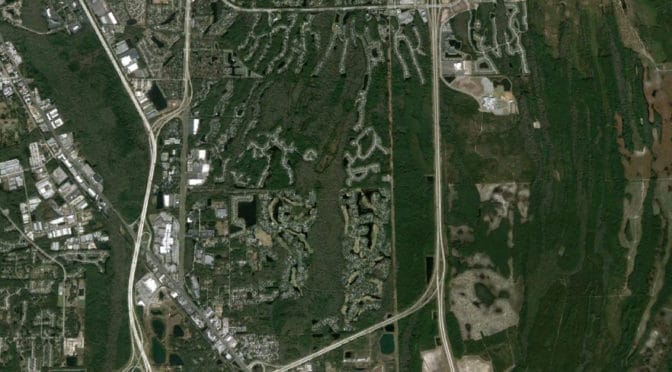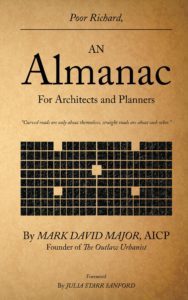The Insidious Landscaping-Agricultural Complex
by Dr. Mark David Major, AICP, CNU-A, The Outlaw Urbanist contributor
President Dwight D. Eisenhower’s warning “against the acquisition of unwarranted influence, whether sought or unsought, by the military-industrial complex” in his farewell address of January 17, 1961 is well-known. What is less well-known is this echoed a similar warning President Eisenhower gave in a speech to the Akron Woman’s City Club in Ohio one year earlier, in which he railed against “the undue influence of the emerging landscaping-agricultural complex in American suburbia.” Many have discounted this lesser-known warning due to suspicions that President Eisenhower might have been suffering from an acute case of panophobia (fear of everything) in the last year of his presidency.
However, as we gaze across Suburbia today, we have reason to believe that President Eisenhower’s warning about the emerging Landscaping-Agricultural Complex was not without merit. In suburban sprawl hell, somewhere in Northeast Florida, mindless minions in service to the orthodoxy of the Landscaping-Agricultural Complex are mulching street signs, fire hydrants, overflow pipes, and electrical transformers. Why? NOTE: These photographs were lost during The Outlaw Urbanist website migration in 2017 but, rest assured, what the article describes about excessive mulching was very real.
 Is there value in moisture retention for a road sign? Are the landscapers nurturing the ‘growth’ of this sign to a more adult height? Or perhaps additional moisture will enable the speed limit to grow above its current 15 MPH level? Is this what occurred with the overflow pipe? Was it originally only six inches in height and, over time, the additional moisture retention of mulching around the pipe enabled its growth an imposing height of two feet? Fire hydrants certainly require water in order to operate (upper right) but I’m pretty sure mulching has nothing to do with how they get water. Finally, why mulch around an electrical transformer (lower right)? It sits on a concrete pad, which is already well-hidden by the grass. Surely this was the point of painting them green in the first place, so they would be less noticeable. Personally, I didn’t even know they existed until they mulched around the base (read: sarcasm).
Is there value in moisture retention for a road sign? Are the landscapers nurturing the ‘growth’ of this sign to a more adult height? Or perhaps additional moisture will enable the speed limit to grow above its current 15 MPH level? Is this what occurred with the overflow pipe? Was it originally only six inches in height and, over time, the additional moisture retention of mulching around the pipe enabled its growth an imposing height of two feet? Fire hydrants certainly require water in order to operate (upper right) but I’m pretty sure mulching has nothing to do with how they get water. Finally, why mulch around an electrical transformer (lower right)? It sits on a concrete pad, which is already well-hidden by the grass. Surely this was the point of painting them green in the first place, so they would be less noticeable. Personally, I didn’t even know they existed until they mulched around the base (read: sarcasm).
The only way I can rationalize this attribute of ‘mulching everything’ is the Landscaping-Agricultural Complex is artificially inflating the per square footage or volumetric costs of the amount of mulch used in this suburban community. Either that, or I am just not smart enough to understand the functional benefits of moisture retention in mulching inanimate objects.




 The intermittent use of white, providing a beautiful contrast to the predominant earth tones, appears principally reserved for representing man-made structural elements (window frames, a roof peak, and foundations). This embeds Floating Houses with a dialogue about the man-nature didactic. Interesting, the use of white (a symbol of purity) for representing these man-man structural components may suggest a positivist perspective on this subject within the composition.
The intermittent use of white, providing a beautiful contrast to the predominant earth tones, appears principally reserved for representing man-made structural elements (window frames, a roof peak, and foundations). This embeds Floating Houses with a dialogue about the man-nature didactic. Interesting, the use of white (a symbol of purity) for representing these man-man structural components may suggest a positivist perspective on this subject within the composition. About Lajos Vajda
About Lajos Vajda



 Blessings on the placemakers,
Blessings on the placemakers,
 The circus of Senate confirmation hearings for the Secretary of Cities, brought to you by National Ready Mixed Concrete Association and Community Organizations International, just as soon as the Senator from Montana releases his hold on the nomination! Stay tuned! More pigs feeding at the Federal trough would inevitably populate Florida’s Department of Cities. That is fine for the pigs but what about the rest of us?
The circus of Senate confirmation hearings for the Secretary of Cities, brought to you by National Ready Mixed Concrete Association and Community Organizations International, just as soon as the Senator from Montana releases his hold on the nomination! Stay tuned! More pigs feeding at the Federal trough would inevitably populate Florida’s Department of Cities. That is fine for the pigs but what about the rest of us? The only way a Federal Department of Cities could alter the prevailing development paradigm in this country for the last century is if we are willing to place Smart Growth for our cities at the top of the agenda by subsuming the Department of Transportation, Department of Housing and Urban Development, Environmental Protection Agency, and other disparate Federal agencies and offices (Office of Urban Affairs, and so on) under one roof. Incidentally, this is probably the only way a new Department of Cities could generate bipartisan support by allowing the left and the right to explicitly address their key constituencies (urban interests on one hand, reducing and streamlining government on the other). It would also require both parties adopting an united front to take on other special interests threatened by such reform (most obviously, radical environmentalists). In the absence of such radical thinking, our cities are safer as “laboratories for pragmatic bipartisan policy innovation, pioneering new approaches on everything from schools, crime and gun control to economic development” at the local and State level.
The only way a Federal Department of Cities could alter the prevailing development paradigm in this country for the last century is if we are willing to place Smart Growth for our cities at the top of the agenda by subsuming the Department of Transportation, Department of Housing and Urban Development, Environmental Protection Agency, and other disparate Federal agencies and offices (Office of Urban Affairs, and so on) under one roof. Incidentally, this is probably the only way a new Department of Cities could generate bipartisan support by allowing the left and the right to explicitly address their key constituencies (urban interests on one hand, reducing and streamlining government on the other). It would also require both parties adopting an united front to take on other special interests threatened by such reform (most obviously, radical environmentalists). In the absence of such radical thinking, our cities are safer as “laboratories for pragmatic bipartisan policy innovation, pioneering new approaches on everything from schools, crime and gun control to economic development” at the local and State level. Why would we expect our citizens (and their representatives) to ever trust us and put us in charge when we have demonstratively failed our cities time and time again during their lifetime, their parents’ lifetime, and their grandparents’ lifetime? Instead of searching for magic bullets (like Florida’s idea), let us dedicate ourselves to leading for our cities. The irony is, if we truly did this, we would probably find the perceived need for Florida’s proposal and others like them would disappear. Unless, of course, the point is to become one of the fattest pigs at the trough. If this is the case, then never mind…
Why would we expect our citizens (and their representatives) to ever trust us and put us in charge when we have demonstratively failed our cities time and time again during their lifetime, their parents’ lifetime, and their grandparents’ lifetime? Instead of searching for magic bullets (like Florida’s idea), let us dedicate ourselves to leading for our cities. The irony is, if we truly did this, we would probably find the perceived need for Florida’s proposal and others like them would disappear. Unless, of course, the point is to become one of the fattest pigs at the trough. If this is the case, then never mind…